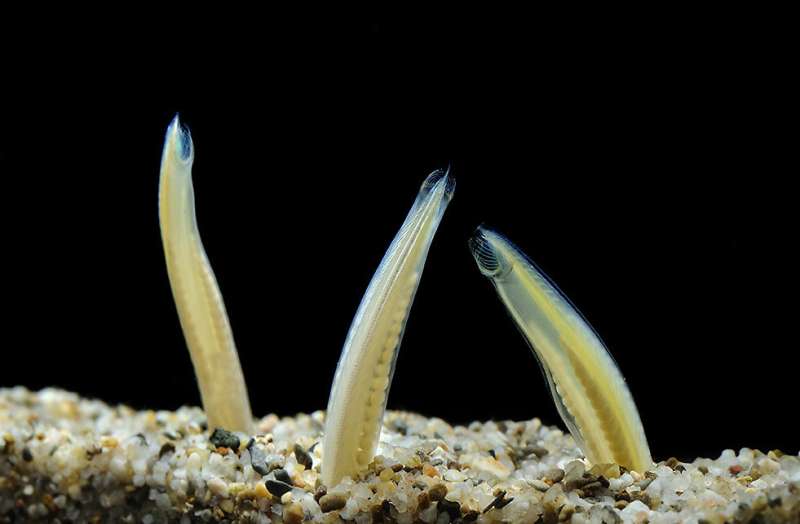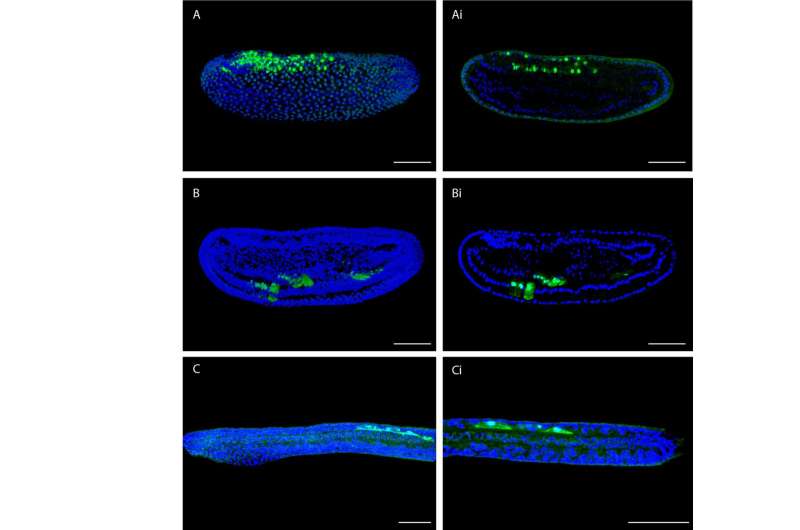What makes vertebrates special? We can learn from lancelets

Scientists once thought that humans must have 2 million genes to account for all our complexity. But since sequencing the human genome, researchers have learned that humans only have about 19,000 to 25,000 genes—not many more than a common roundworm. Now, evidence suggests humans and other vertebrates gained their unique attributes not from sheer number of genes, but from how they regulate the genes they have.
A new study published in Nature on November 21, 2018, gives a glimpse into the origins of vertebrate gene regulation. The researchers studied the lancelet, or amphioxus, an organism in the chordate phylum that lacks the unique attributes of a vertebrate, such as a head, eyes and limbs, but shares a similar body plan. Learning how the lancelet controls its gene activity clarified which control mechanisms evolved with vertebrates, and which were around already.
"If you really want to understand what makes vertebrates, mammals, humans special, you need to have this basis to compare them, evolutionarily," said Ferdinand Marlétaz, co-first author of the study and a postdoctoral scholar in the OIST Molecular Genetics Unit.
Scientists hypothesize that beyond lancelets on the evolutionary tree of life, organisms accrued extra copies of their entire genomes. Evidence suggests that the entire vertebrate genome underwent two duplications, leaving evolution extra copies of each gene to play with. These two whole genome duplications are thought to have driven vertebrate innovation—the introduction of genetic characteristics unique to vertebrates. "The idea is that these two rounds of whole genome duplication promoted the evolution of so-called 'vertebrate novelties'—for example, the head and the limbs," said Marlétaz.

The development of new characteristics relied heavily on new types of gene regulation, which allowed vertebrates to turn specific genes on and off. However, scientists had never connected the dots from genome duplication to these newfound regulatory controls. By comparing the lancelet to vertebrates, such as the zebrafish, the study authors drew these connections.
The researchers found that the lancelet genome contains far fewer regulatory regions than vertebrate genomes, though both contain about the same number of genes. Vertebrate genome duplication may have cleared space for these additions, as genes were lost in the process and left gaps between those left behind. The remaining genes became subject to tight control over time, and as duplicate genes diverged in function, the scientists hypothesize that different tissues may have started to evolve.
The results also revealed a regulatory mechanism in lancelets formerly thought to be unique to vertebrates. Chemical structures known as methyl groups appear in abundance on vertebrate genomes and regulate the genes they're attached to. During development, vertebrates lose many methyl groups and thus alter their gene regulation. Though few methyl groups adorn lancelet genomes, the research suggests that they also discard the molecule as a form of gene control.
The result shifts demethylation to an earlier slot along the evolutionary timeline. Given more data, scientists may learn that other forms of gene regulation appeared sooner, or later, than we once thought.
"We need more of these types of studies," said Marlétaz, "to understand what the main differences are in terms of gene regulation in different animals. Even now, we still know surprisingly little."
Using methodologies employed in the Nature study, Marlétaz now studies squids in the Molecular Genetics Unit. Squids share many complex characteristics with vertebrates, such as having eyes and large brains, and represent another step along the evolutionary timeline. Studying squids using similar methods to the lancelet study should deepen scientists' understanding of gene regulation even further.
More information: Ferdinand Marlétaz et al, Amphioxus functional genomics and the origins of vertebrate gene regulation, Nature (2018). DOI: 10.1038/s41586-018-0734-6
Journal information: Nature
Provided by Okinawa Institute of Science and Technology

















